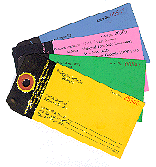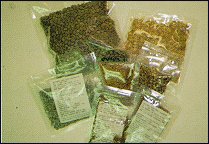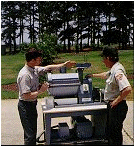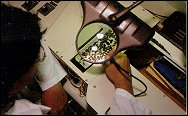|
|
| |
 |
The National Seed Laboratory
|
The Mission
|
| Worldwide and national interest in planting trees is at
an all-time high. Campaigns carried out by such groups as
American Forests (Global ReLeaf)
and the National Arbor Day
Foundation are signs of this high interest. The success
of these and other planting programs depends on high-quality
seedlings - and good seedlings start with high quality seed.
The mission of the National Seed Laboratory is to assist
in providing a quality start for global reforestation. |
 
|
| Seed Certification |
| Planting seeds or seedlings that are not adapted to
the planting site or suited to the landowners management objectives
can lead to planting failure, financial loss because of poor growth
or disease, or damage to the environment by disrupting naturally occurring
plant populations. Seed certification is the process of certifying
the genetic identity of seeds for agricultural, horticultural, or
forest and conservation plantings. It can be extended to include the
seedlings produced from certified seed when seedlings and not seeds
are planted by the end user. This process either certifies that the
variety or source of plant material (seed, seedling, or cutting) is
adapted for the planting area or that the genetic identity is completely
and unambiguously stated so that the landowner can make an informed
and responsible decision about the materials planted. Seed certification
is done by the individual states. Some states have active certification
programs in trees and native plants while others have yet to develop
their program. For information on the certification agency in your
state, contact the Association of Official Seed Certifying Agencies
at http://www.aosca.org |

Certification is generally offered at four levels. The first is simply
to identify the source of seed, where are the parent plants growing and
what is known about their origin. This category is referred to as source
identified and is marked with yellow tags. The next category is stands
of plants that are above average in some particular trait. This is the
selected category and is marked with green tags. When plants are assembled
in one planting site from various locations because of their above average
appearance (superior phenotypes), it is called a seed orchard. Initially
this seed orchard is called phenotypically superior and marked with pink
tags. When progeny, seedlings or seeds, from a seed orchard are proven
to be genetically superior in a test, they are classified as tested and
marked with a blue tag.
The National Seed Laboratory assists with certification programs
by participating in the Northwest Forest Tree Seed Certifiers Association,
the Tree, Shrub, and Native Plants Committee of the Association of Official
Seed Certifying Agencies, and by serving as the designated authority from
the United States to the Scheme for the Certification of Forest Reproductive
Materials Moving in International Trade operated by the Organization for
Economic Cooperation and Development. Assistance has also been provided
to individual states as they develop or administer their tree and native
plant seed certification programs.

| In 1972, the U.S. Department of Agriculture appointed the National Seed Laboratory to serve as the National Seed Coordinating
Center for the Exchange of Forest Tree Germplasm among countries
participating in the Food and Agricultural Organization (FAO) of
the United Nations. Laboratory personnel assist embassies and other
agencies in locating tree seed and in avoiding duplication of effort
in filling international requests. |
| The seed bank provides small lots of native tree and shrub seeds
to forest researchers outside the United States. The seed is available
in quantities of either 200 or 2,500 seeds, according to customer
preference. More than 150 species have been shipped to 95 countries
since 1972. |
 |
Seeds are packaged and shipped
to forestry researchers and other clients around the world. |

| Technology Adaptation |
The National Seed Laboratory is at the forefront in developing
new forest seed technology. The latest equipment for seed conditioning
and seed testing is evaluated and adapted for use with tree seed.
New ideas to improve the seed-to-seedling ratio in forest nurseries
are evaluated cooperatively with nursery and reforestation personnel.
|
 |
Laboratory personnel discuss the
latest technologies relating to hardwood seed. |
| Troubleshooting |
| Tree seed users are assisted in solving their collection, conditioning,
handling, testing, and other seed related reforestation problems.
Short-term studies are conducted to determine what corrective action
is needed. Seeds of any forest plant can be submitted. Contact the
laboratory (Contact Us page)for arrangements
to submit a seed lot for examination
or conditioning. |
| Training |
The National Seed Laboratory is a model for other organizations
testing tree seed. Individual and group training is provided on
testing procedures and the interpretation of the seed test results.
Such training also extends to agencies in other countries. Foreign
scientists and practitioners frequently spend short training periods
at the lab to study the latest techniques in analyzing tree seed.
Workshops are also presented on conditioning seeds. These are done
both at the laboratory and at cooperators' locations. Workshops
are organized to meet the clients particular needs. Past workshops
have emphasized hardwoods, conifers, prairie plants and combinations
of them. Contact the laboratory (Contact Us
page) for workshop dates or to arrange for a workshop in your
area. |
 |
Outside groups visit
the lab for training in proper seed sampling techniques. |

| The National Seed Laboratory provides seed testing services
to both small and large private firms, state governments, national
forests and other federal agencies. The results of these test
are used in forest nurseries to determine sowing rates, in seed
conditioning plants to evaluate product quality, and by seed dealers
to determine price.
The National Seed Laboratory measures seed quality with
the following tests: germination, purity, moisture content,
and seed per pound. Rapid estimates of viability are made by
using chemical stains, embryo excision and x-rays. All tests
for domestic use are performed according to the rules of the
Association of Official Seed Analysts (AOSA).
|

Seeds are examined carefully to avoid mixing
species and to detect contaminants. |
|

Pure seeds are germinated under ideal conditions
in a controlled environment. |
| The National Seed Laboratory is accredited by the International Seed Testing
Association (ISTA) and can issue ISTA seed analysis certificates. These certificates
report seed test results required for international sales. |
| As members of AOSA and ISTA, the laboratory's specialists develop
the official seed testing criteria and procedures for U.S. native
tree and shrub species. |
| Seed Test Definitions
Germination of seed in a laboratory test
is used to predict the probability that the seed will produce
a normal plant under favorable conditions. The test measures
the percentage of seeds that germinate and the speed of germination.
Moisture content is the percentage of water
held by the seed. It is calculated by measuring the loss of
weight by the seed when it is dried at a constant temperature
for a specific period of time. Moisture content is a critical
factor in storing seed because seed that is too moist cannot
be stored and will deteriorate rapidly.
Purity distinguishes the amount and type
of impurities in a seed sample. The impurities are physically
removed from the seed sample in the laboratory leaving only
the pure seed. A minimum weight that contains 2500 seeds is
needed to conduct the test.
Seeds per pound determines the number of
individual seeds in a pound. This value is used with the germination
percentage and purity percentage to predict the number of seedlings
expected to be produced by a given weight of seeds.
Estimated viability tests are for quickly
determining the number of live seeds in a sample. The tetrazolium,
excised embryo, and x-ray tests are the viability tests used
most frequently at the laboratory. They are the preferred tests
for very dormant seeds (seeds that are difficult to germinate).
In the tetrazolium test, a colorless solution
of tetrazolium chloride is imbibed by the seed. Living tissues
then stain red while dead tissues retain their natural color.
Properly stained seeds are considered viable while improperly
stained or unstained are generally considered non-viable seeds.
In the excised embryo test, the embryos are
excised and incubated under prescribed conditions for 5 to 14
days. Viable embryos remain firm or exhibit evidence of growth
while non-viable embryos show signs of decay.
X-radiography is used to examine the internal
structures of the seed. It provides a quick, nondestructive
method of differentiating between filled, empty, insect damaged,
and physically damaged seed.
|
|

